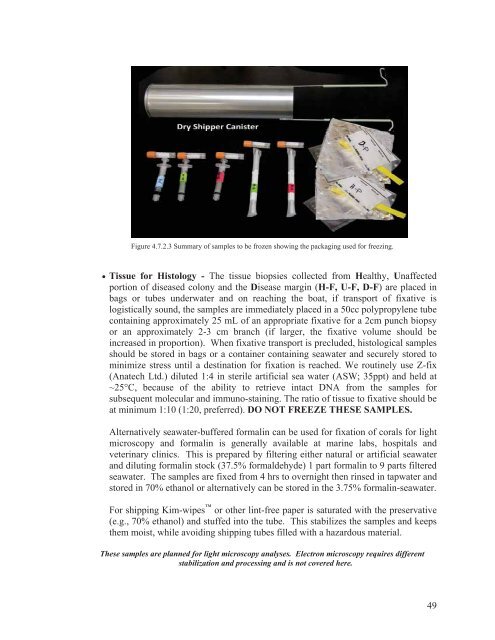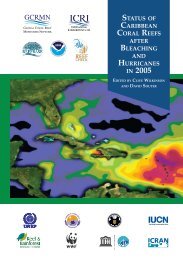Field Manual for the Investigation of Coral Disease Outbreaks
Field Manual for the Investigation of Coral Disease Outbreaks
Field Manual for the Investigation of Coral Disease Outbreaks
You also want an ePaper? Increase the reach of your titles
YUMPU automatically turns print PDFs into web optimized ePapers that Google loves.
Figure 4.7.2.3 Summary <strong>of</strong> samples to be frozen showing <strong>the</strong> packaging used <strong>for</strong> freezing. Tissue <strong>for</strong> Histology - The tissue biopsies collected from Healthy, Unaffectedportion <strong>of</strong> diseased colony and <strong>the</strong> <strong>Disease</strong> margin (H-F, U-F, D-F) are placed inbags or tubes underwater and on reaching <strong>the</strong> boat, if transport <strong>of</strong> fixative islogistically sound, <strong>the</strong> samples are immediately placed in a 50cc polypropylene tubecontaining approximately 25 mL <strong>of</strong> an appropriate fixative <strong>for</strong> a 2cm punch biopsyor an approximately 2-3 cm branch (if larger, <strong>the</strong> fixative volume should beincreased in proportion). When fixative transport is precluded, histological samplesshould be stored in bags or a container containing seawater and securely stored tominimize stress until a destination <strong>for</strong> fixation is reached. We routinely use Z-fix(Anatech Ltd.) diluted 1:4 in sterile artificial sea water (ASW; 35ppt) and held at~25°C, because <strong>of</strong> <strong>the</strong> ability to retrieve intact DNA from <strong>the</strong> samples <strong>for</strong>subsequent molecular and immuno-staining. The ratio <strong>of</strong> tissue to fixative should beat minimum 1:10 (1:20, preferred). DO NOT FREEZE THESE SAMPLES.Alternatively seawater-buffered <strong>for</strong>malin can be used <strong>for</strong> fixation <strong>of</strong> corals <strong>for</strong> lightmicroscopy and <strong>for</strong>malin is generally available at marine labs, hospitals andveterinary clinics. This is prepared by filtering ei<strong>the</strong>r natural or artificial seawaterand diluting <strong>for</strong>malin stock (37.5% <strong>for</strong>maldehyde) 1 part <strong>for</strong>malin to 9 parts filteredseawater. The samples are fixed from 4 hrs to overnight <strong>the</strong>n rinsed in tapwater andstored in 70% ethanol or alternatively can be stored in <strong>the</strong> 3.75% <strong>for</strong>malin-seawater.For shipping Kim-wipes or o<strong>the</strong>r lint-free paper is saturated with <strong>the</strong> preservative(e.g., 70% ethanol) and stuffed into <strong>the</strong> tube. This stabilizes <strong>the</strong> samples and keeps<strong>the</strong>m moist, while avoiding shipping tubes filled with a hazardous material.These samples are planned <strong>for</strong> light microscopy analyses. Electron microscopy requires differentstabilization and processing and is not covered here.49
















